2005 年福建医大考博英语真题
Part I. Reading Comprehension
Directions: Read the following five passages. Answer the questions below each passage by
choosing A, B, C or D. Mark your answer on ANSWER SHEET.
Passage One
(40%)
Most American women know regular Pap smears cut the risk of cervical cancer, but that
doesn’t mean they go in to get the test. Half the women who develop the disease haven’
t had a Pap test for three years. But a new test may one day offer a user—friendlier
alternative. Two studies in last week’s Journal of the American Medical Association report
that a DNA test detects cervical cancer just as well as Pap smears do. Better yet, women
can collect samples for the test themselves. The Pap smear has caused a fivefold drop in
cervical cancer since 1960s. But since a doctor must take the smear during a pelvic exam,
women who don’t have access to gynecologists aren’t screened. So a self-collected test
could be good news for patients, like the 1,365 South Africans in one of the JAMA studies.
They collected their own vaginal samples on swabs. Samples were sent to the United States,
where a DNA test caught 66 percent of the women’s cervical cancers; 68 percent were detected
by Pap smears. And when doctors collected the samples, that study, and a second one of Costa
Rican women, found that DNA tests actually caught more cancers than Pap smears.
Does this mean women can bid farewell to the Pap test? Probably not. Doctors think
cervical cancer is caused by the transmitted human papilloma virus. The DNA test detects
genetic material from 13 forms of it, which are found in 96 percents who have cervical cancer.
But most young women who have papilloma virus don’t actually develop cancer. So the test
can cause false alarms. DNA tests could prove useful for older women, though. Most women
fight off the virus before they turn 40. If they don’t, they’re more likely to get cervical
cancer. But they ’ re also less likely to get Pap smears because many stop visiting
gynecologists after childbearing age, and the test gets more uncomfortable. So a quick,
self-collected test could cut cervical cancer rates: “If we could make screening as easy
as a urine test at the doctor’s office, we would get more coverage,” says Thomas Wright,
lead author of the South African study and associate professor of Pathology at Columbia.
Though true home testing awaits FDA approval and could be years away, general practitioners
could administer the test, too.
Detection is one thing; treating cervical cancer is another. Doctors recently announced
that a combination of radiation and chemotherapy can cut the risk of death 30 to 50 percent.
And researchers hope to someday prevent papilloma infections: “Ultimately, vaccines will
be the best way we prevent cervical cancer worldwide,” Wright predicts. But for now, the
DNA test could help mainly in countries that can afford the $6 billion the United States
spends on Pap screening every year. But there’s one important caveat: a new test will be
useful only if patients can get medical treatment afterward.
1.
The Pap smear __________________________.
A) has caused a fivefold drop in cervical cancer since the 1960s
B) caught 66 percent of the women’s cervical cancers
C) Caught more cancers than the DNA Test
D) Is very convenient for women to do self-examination
�
2.
Why the DNA test cannot replace Pap smear?
A) Doctors think cervical cancer is caused by the sexually transmitted human papilloma
virus.
B) The DNA test detects genetic material from 12 forms of papillooma virus, which are
found in 96 percent of patients who have cervical cancer.
3.
C) Most young women who have papilloma virus don’t actually develop cancer.
D) The DNA test can cause false alarms.
Which of the following statement is not correct?
A) Home DNA test has not yet been approved by DNA.
B) DNA tests could prove useful for older women. Most women fight off the virus before
they turn 40.
C) Doctors recently announced that a combination of radiation and chemotherapy can cure
cervical cancer.
D) The DNA test could help mainly in countries that can’t afford the $6 billion the
United States spends on Pap screening every year.
Passage Two
Although language is used to transmit information, the informative functions of
language are fused with older and deeper functions so that only a small portion of our
everyday speech can be described as purely informative. The ability to use language for
strictly informative purposes was probably developed relatively late in the course of
linguistic evolution. Long before that time, our ancestral species probably made the sorts
of cries animals do to express feelings of hunger, fear, loneliness, and the like. Gradually
these noises seem to have become more differentiated, transforming the cries into language
as we know it today.
Although we have developed language in which accurate reports may be given, we still
use language as vocal equivalents of gestures such as crying in pain. When words are used
as the vocal equivalent of expressive gestures, language is functioning in pre-symbolic
ways. These pre-symbolic uses of language coexist with our symbolic system, so that the
talking we do in everyday life is a thorough blending of symbolic and pre-symbolic language.
What we call social conversation is mainly pre-symbolic in character. When we are at
a large social gathering, for example, we all have to talk. It is typical of these
conversations that, except among very good friends, few of the remarks made have any
informative value. We talk together about nothing at all and thereby establish a
relationship.
There is a principle at work in the selection of the subject matter we deem appropriate
for social conversation. Since the purpose of this kind of talk is the establishment of
communion, we are careful to select subjects about which agreement is immediately possible.
With each new agreement, no matter how commonplace, the fear and suspicion of the stranger
wear away, and the possibility of friendship emerges. When further conversation reveals
that we have friends or political views orartistic values or hobbies in common, a friend
is made, and genuine communication and cooperation can begin.
4.
The author uses the term “pre-symbolic language” to mean ______________________.
A) language used between friends
B) language that lacks an elaborate grammatical structure
�
C) nonverbal expressions used in communicating
D) language that does not convey specific information
The primary value of pre-symbolic language for humans is that it ___________________.
A) Is common to all languages rather than unique to any one language
B) Permits and aids the smooth functioning of interpersonal relationships
C) Helps us understand and express our emotions
D) Allows for a desirable amount of social mobility
The most crucial difference between pre-symbolic and symbolic language lies in the
5.
6.
____________.
A) origin and developmental path of each mode in linguistic evolution
B) degree to which each mode may be accompanied by expressive gestures
C) purposes served by each mode
D) clarity each mode makes possible
Passage Three
In the ultrasound clinic, Suzie Woods stared at the screen in front of her. The
sonographer pressed the foetal probe over her abdomen, already stretched into a taught
little mound by months of pregnancy. “There are two embryos on the screen,” he told her.
“No, no, there should only be one,” Suzie insisted, her eyes now fixed intently on his.
“Look, I’ll show you,” he said. “There are two hearts beating on the screen.” “That
moment,” recalls Suzie, “would have to have been the most electric of my life. I was
absolutely ecstatic that these two gorgeous little people were all mine. “Suzie and the
twins — Simon and Sabrina, now seven months — are part of an international population
explosion, a twin boom in Western developed societies.
Reluctant to interrupt satisfying careers, women are having babies later in life and
increasingly using fertility treatments. These two factors mean Australian mothers are
having more twins than ever before. In 1998, 3,592 sets of twins were born in Australia,
a 25 percent increase on the figure of 2,871 just 10 years earlier. This is despite static
figures for the total number of births in 1988 and 1998. And the trend to multiple births
shows no sign of abating. King George V hospital in the inner Sydney suburb of Camperdown,
for instance, has just beaten its own record: 68 twins were born in the past six months
—an increase of 40 percent on the previous six months, says the director of obstetrics,
Dr. Andrew Child. Overseas, the number of twins born in the United States has doubled since
1980 and a similar, though more moderate, trend is evident in Britain, where twins as a
proportion of all births are up a third since 1982.
A twin industry has been spawned, especially in the U.S., where you can now have your
baby delivered by a specialist twin obstetrician and looked after by specialist nannies.
There are 10 US magazine title aimed at the parents of twins and at least three dozen books,
along with twin strollers ans a whole range of other specialized goods. In Australia, there
is a new acceptance of the problems confronting the parents of twins, and mothers of twins
leaving hospital have access to an ever-widening circle of support and services. The NSW
Multiple Birth Association has mushroomed from one support group of three mothers to 34
clubs across the State in just 10 years.
Most are bristling with activity, regularly sending newsletters and social calendars
to parents, holding information evenings and support groups, and offering hotlines, a
�
library service and even advice on what brand of twin stroller mothers should buy. More
importantly, these groups are as generous with camaraderie as practical advice. “Often
it was quicker to ring the Multiple Birth Association than look up the baby manual,” says
Suzie, who soon discovered that the euphoria at having twins was followed by a whole caravan
of complications after they arrived.
7.
Why the Australian mothers are having more chances to have twins than ever before?
A) Career women do not want to have babies early because they enjoy satisfying
professions or they have to work for a living.
B) Australian women are born to have genetic capabilities to bear twins.
C) Australian women are strong and fertile comparatively.
D) Australian women prefer to use fertilizer in pregnancy.
The author mentioned Suzie Woods at the beginning of the article to __________________.
A) make his article sound catchy
B) express how ecstatic Suzie was when she knew she had two embryos
C) portray the following topic of the article
D) condemn the twin boost in the western countries
What is the fact of Australia’s twin boom, according to the passage?
A) In 1998, 3,592 sets of twins were born in Australia, a 25 percent increase on the
8.
9.
figure of 2,871 just 10 years earlier.
B) The trend to multiple births shows no sign of declining.
C) 68 twins were born in the past six-months in King George V Hospital in the inner
Sydney suburb of Camperdown, which is an increase of 40 percent on the previous six
months.
D) All of the above.
10. Which of the following statement is NOT true about U.S. according to the passage?
A) There are many magazines and books aimed at the parents of twins in U.S.
B) There is a new acceptance of the problems confronting the parents of twins, and
mothers of twins leaving hospital have access to an ever-widening circle of support
and services.
C) Parents can have their babies delivered by a specialist twin obstetrician and looked
after by specialist nannies.
D) The number of twins born in the United States has doubled since 1980.
Passage Four
Until recently doctors were taught that the human body lives in homeostasis, changing
little during the day. The science of chronobiology—the study of how time affects life
—is sparking a medical revolution by revealing how much our bodies change through circadian
(daily) rhythms.
These natural biological rhythms are as vital as our heart beat. By learning their
secrets, we are discovering new ways to prevent and cure illness. There isn’t a function
in your body that doesn’t have its own rhythm.
While you sleep, your blood pressure falls, our temperature drops more than a degree
from its daily afternoon high, and some blood pools in your body’s extremities. Come morning,
the body has to “jump start” itself from its sleeping to waking stages with a surge of
excitation chemicals calls catecholamines. Heart rate increases and blood vessels constrict,
�
raising blood pressure and reducing blood flow to heart muscle; this might cause ischemia,
or angina, as well as sudden death from myocardial infarction. If hardened plaques of
cholesterol coat arteries, fragments may break loose, causing the clots that lead to heart
attacks.
When a leap from bed and a surge of catecholamines combine to “get your blood moving”,
your blood is near its daily peak in thickness and tendency to clot. Packing kids off to
school and rushing to get ready for work add emotional tension to the physical stress.
This circadian cardiovascular risk comes not from your bedside clock but from your
interior biological clock. Whatever hour you get up, your peak risk of myocardial infarction
will come within two to three hours after awakening.
The master timekeepers in our bodies help synchronize us with such outside cycles as
day and night. Like orchestra conductors, they coordinate hundreds of functions inside us.
Our body dances through the day to complex inner rhythms of rising and falling tides of
hormones, immune cells, electrolytes and amino acids.
Most people enjoy a peak in short-term memory and mental quickness in the late-morning
hours until shortly afternoon. Then a measurable dip in energy and efficiency begins around
1 p.m. In some Mediterranean cultures, shops close during the afternoon for a period of
siesta.
In the afternoon, exercise endurance, reaction time and manual dexterity are at their
highest. Some research indicates that from then until early evening, athletes put in their
best performances. From 6:30 p.m. until 8:30 p.m. is the sharpest time of day for long-term
memory, an optimal time to study.
Our daily rhythms can bring a dark side to the evening, however. These hours include
a second daily peak in heart attacks, although smaller than the morning’s. Around 7 p.m.,
alcohol takes longer to be cleared by your liver, and hence can be more intoxicating and
performance-impairing than at other times of day—except 11 p.m. which brings a second peak
of high ethanol susceptibility.
Students often cram during late-night and early-morning hours. Research, however, shows
this is the time of the circadian cycle when long-term memory, comprehension and learning
are at their worst.
Sensitivity to pain has generally increased throughout the day; it reaches its peak
late at night. But by early morning the body may have doubled its night time levels of beta
endorphins, which help relieve pain. Researchers theorize that this is what increases the
body’s pain tolerance during the hours after awakening.
For most of us, sleep is a time of life renewal. Within the first 90 minutes or so of
sleep, we reach our daily peak of growth hormone, which may help regenerate our bodies.
By understanding our body clocks, we can improve our health and continue to foster our
survival. Without grasping, for instance, that our natural temperature rises one to two
degrees from morning until evening, we could misjudge thermometer readings, A temperature
of 99 degrees might signal perfect health at 5 p.m. but augur illness at 7 a.m.
The effects of drugs are also subject to our rhythms. For instance, many doctors are
learning to give powerful cancer drugs with the patient’s biological clocks in mind. A
given chemotherapy drug may be highly toxic to the kidneys at one time of day, for example,
and far less harmful at another.
�
By turning the cycles of your biological clock in your favor, you may reduce your daily
danger and increase your days of life.
11. No matter what hours you get up, sudden rise from bed ___________________.
A) brings energy to one’s morning work
B) should help form a good habit
C) may cause heat attacks
D) increases heart rate to normal action
12. The passage advises that to improve our health, it is essential to ___________________.
A) avoid sitting up late
B) do the right thing at the right time
C) get up as soon as the bedside clock gives alarm
D) understand our body clock
13. In the author’s opinion, physical stress should be avoided _________________________.
A) as soon as you awake
B) two to three hours after awakening
C) around 1 p.m.
D) in the late evening
14. If you want to take some pills to kill your pain, you ’ d better take them
____________________.
A) after lunch
B) before going to bed
C) in the early morning
D) late at night
15. According to the passage, it is harmful to ______________________.
A) do morning exercise at about 6 o’clock
B) neglect the doctor’s advice about the time to take drugs
C) go to sleep again after awakening
D) do memory work in the late-morning hours
Passage Five
As a person now publicly identified with the movement to reform our drug laws through
the use of some form of decriminalization, I consider it very important to say that I am
not soft on either drug use or drug dealers. I’m a soldier in the war against drugs. I
spent years prosecuting and jailing drug dealers, and had one of the highest rates of
imprisonment for drug convictions in the country. And if I were still State’s Attorney,
I would be enforcing the law as vigorously as ever. My experience as a prosecutor did not
in any way alter my passionate dislike for drug dealers, it simply convinced me that the
present system doesn’t work and can’t be made to work.
As State’s Attorney, I was confronted daily with the victims of our drug crimes, who
for the most part are ignored by the opponents of drug decriminalization. One of my most
painful duties as State’s Attorney was prosecuting drug dealers who injured and sometimes
killed police officers. In Baltimore, as in so many other cities, our police officers and
plan-clothes agents serve with distinction and uncommon bravery. Their work is dangerous
and needs to be highly commended. But that is no reason to ignore common sense. The end-game
in the war on drugs is not less supply or mo0re jails, or even the death penalty. It’s
�
less profit and less demand—and that will only come about through increased efforts at
treatment and prevention.
A good general does not pursue a strategy in the face of overwhelming evidence of failure.
Instead, a good general changes from a losing strategy to one that exploits his enemy’
s weakness while exposing his own troops to only as much danger as is required to win. The
drug dealers can be beaten and the public health of the United States can be improved if
we’re willing to substitute common sense for myth and blind persistence.
16.
problem
_____________________.
argument
passage
is
weather
The
central
about
the
of
the
drug
A) decriminalization will be accepted by the public
B) the authorities are firm and determined on drug use
C) the police officers are dedicated to their duties
D) a reform in policy should be enforced
17. Throughout the passage the author shows his concern over ______________________.
A) the appeal to the lawfulness of drug addition
B) the lives of those who fight at the forefront against drug dealers
C) his reputation as an experienced soldier in the war against drugs
D) drug dealers at large who are prosecuted and jailed
18. The end-game (Para. 2) is closest in meaning to ___________________________.
A) the end purpose
B) the final endeavor
C) the decisive strategy
D) the last moment decision
19. According to the passage, the aim to be achieved in the fight against drugs is
___________________.
A) to cut off the supply of drugs and severely punish drug dealers
B) to take every measure to prevent people from taking drugs
C) to make drugs less demanded and less profitable
D) to offer medical treatment to the victims of drug crimes
20. It can be inferred from the passage that drug decriminalization ______________________.
A) will encourage drugs abuse
B) has caused much controversy
C) has proved to be a happy solution
D) will encounter attacks from drug dealers
Part II
Directions: There are 30 incomplete sentences in this part. Choose the one that best complete
Vocabulary
( 15% )
the sentence. And write your answer on the ANSWER SHEET.
21. The effort ___________ skepticism from psychologists who find it frivolous.
D) proposes
B) proportions
A) protests
C) provokes
22. As my father is not ___________ with the language, he has asked me to assume the role
of private secretary and meet you on his behalf.
A) lounged
C) acquainted
B) logged
D) omitted
23. He had an ___________ habit of emptying ash trays out of his upstairs window onto our
door step.
�
A) objectionable
B) afflicting
C) uneducated
D) offending
24. The jury ___________ him for having committed the robbery and he was then sentenced
to five years’ imprisonment.
A) accused
B) charged
C) acquitted
D) convicted
25. The plan was _____________ when it was discovered just how much the scheme would cost.
A) resigned
B) abandoned
C) released
D) redeemed
26. When people have their basic needs satisfied, they begin to think of other things to
fulfill their life ____________.
A) necessities
B) requirements
C) appreciations
D) expectations
27. The awards for the job include a competitive tax-free salary, ___________ educational
assistance plan and high standard of free accommodation and utilities.
A) triumphant
C) terrific
B) trivial
D) timid
28. It was manifest that ____________ red light of day did not come from the sun.
A) wary
B) weird
C) waxy
D) weary
29. He could scarcely resist taking another drink of the delicious wine, but remembering
the doctor’s advice, he _________________.
A) refrained
B) withdrew
C) avoided
D) retreated
30 the outflow of professionals to rich countries may create a severe bottleneck in the
development of the ___________ technology in our country.
A) excellent
B) marvelous
C) splendid
D) sophisticated
31. This legislation also limited the workday of children between 14 and 18 years of age
to 12 hours, with an ___________ of 2 hours for meals and rest.
A) intervention
D) intersection
32. The doctor promised that this medicine would ____________ the pain in the stomach.
B) intermission
C) interruption
A) affirmed
B0 agitated
C) alleviate
D) allocate
33. The idea of a balanced diet is very difficult to ____________ anyone who knows nothing
about food values.
A) give up
B) take in
C) put across
D) make over
34. He was sent to hospital as a big nail __________ through the sole of his shoe, right
into his foot.
A) pierced
B) pinched
C) pursued
D) radiated
35. The officer inspected our passports and travel papers and ____________ us because our
vacation certificates were missing.
A) contained
B) sustained
C0 detained
D) retained
36. The question of ___________ agent is still under consideration and we hope that you
will continue your efforts in pushing the sale of our product at present stage.
A) creative
D) perspective
C) intensive
B) exclusive
37. According to the psychoanalyst Sigmund Freud, wisdom comes from the ___________ of
maturity.
A) fulfillment
accomplishment
B) achievement
C) establishment
D)
38. Jim’s plans to go to college ____________ at the last moment, which depre4ssed him
very much.
A) fell out
B) gave away
C) gave off
D) fell through
�
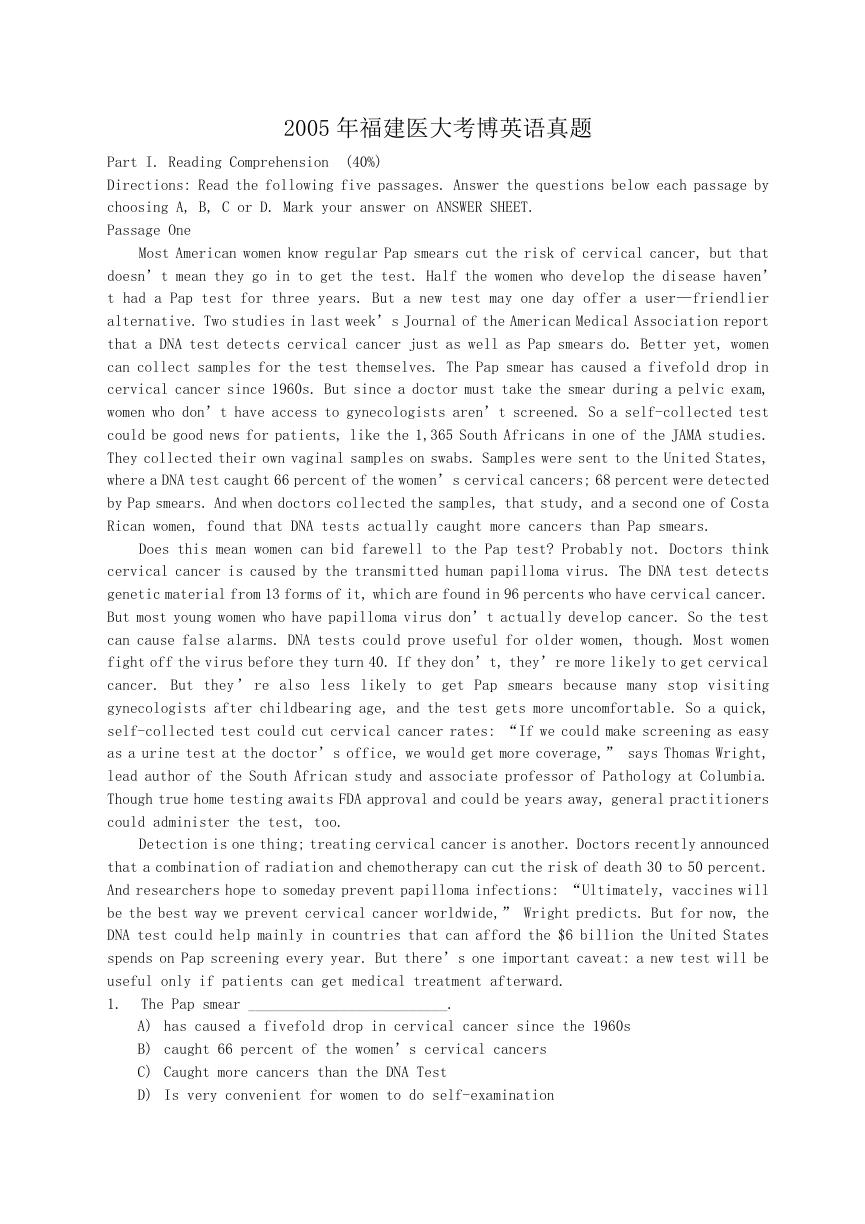
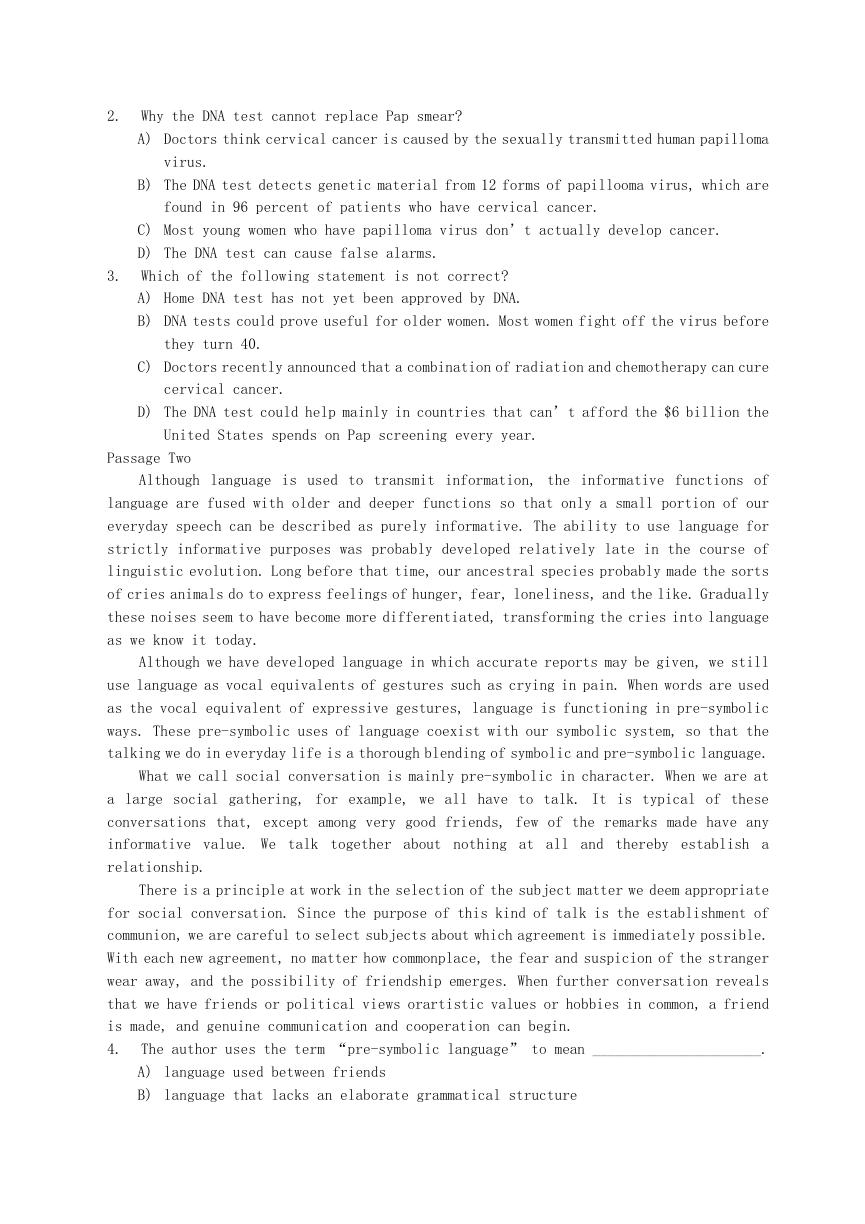
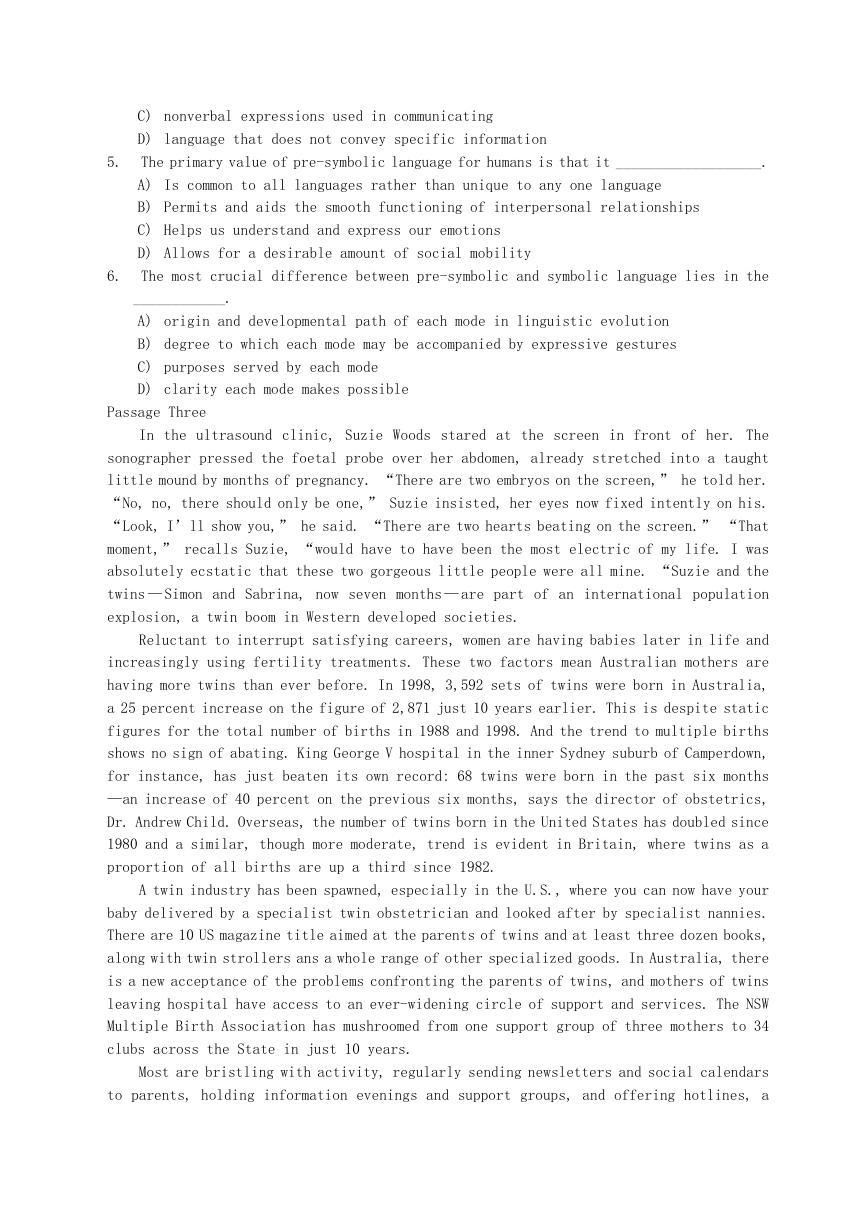

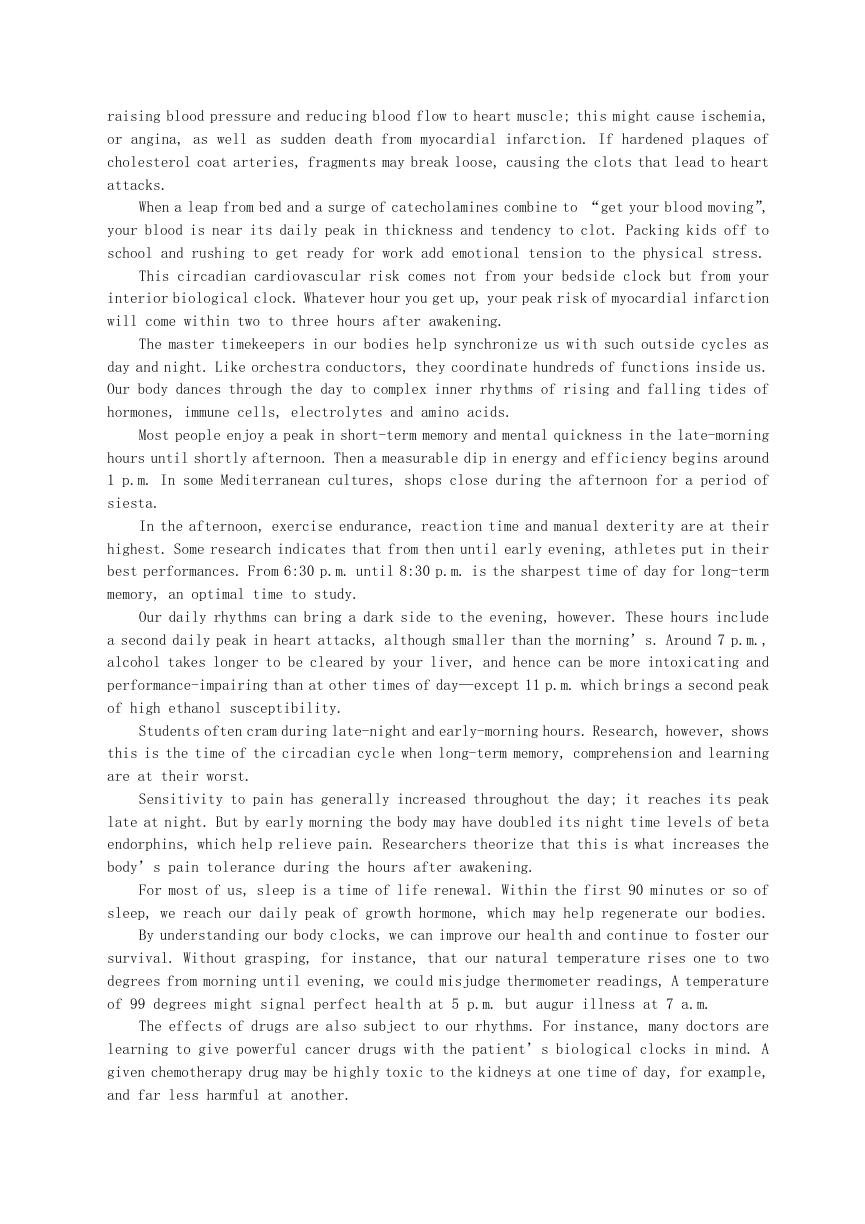
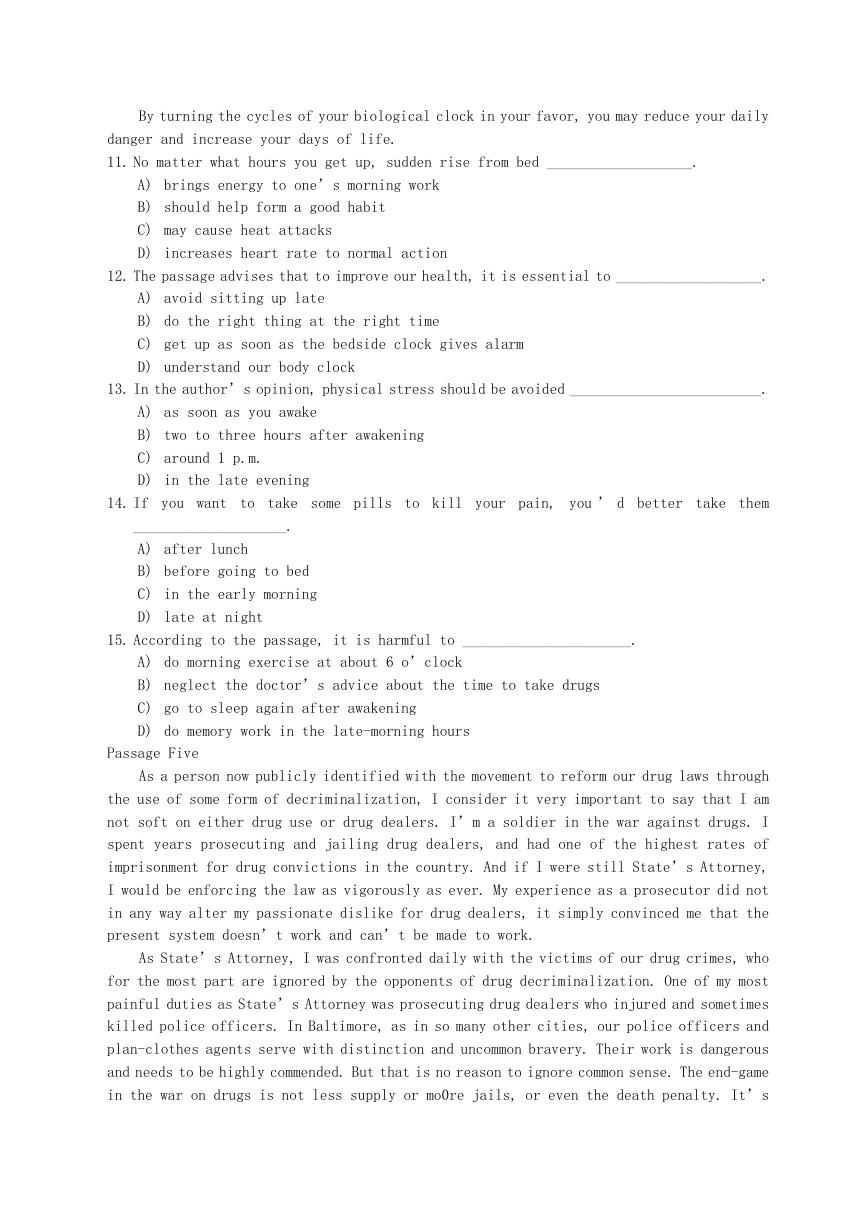
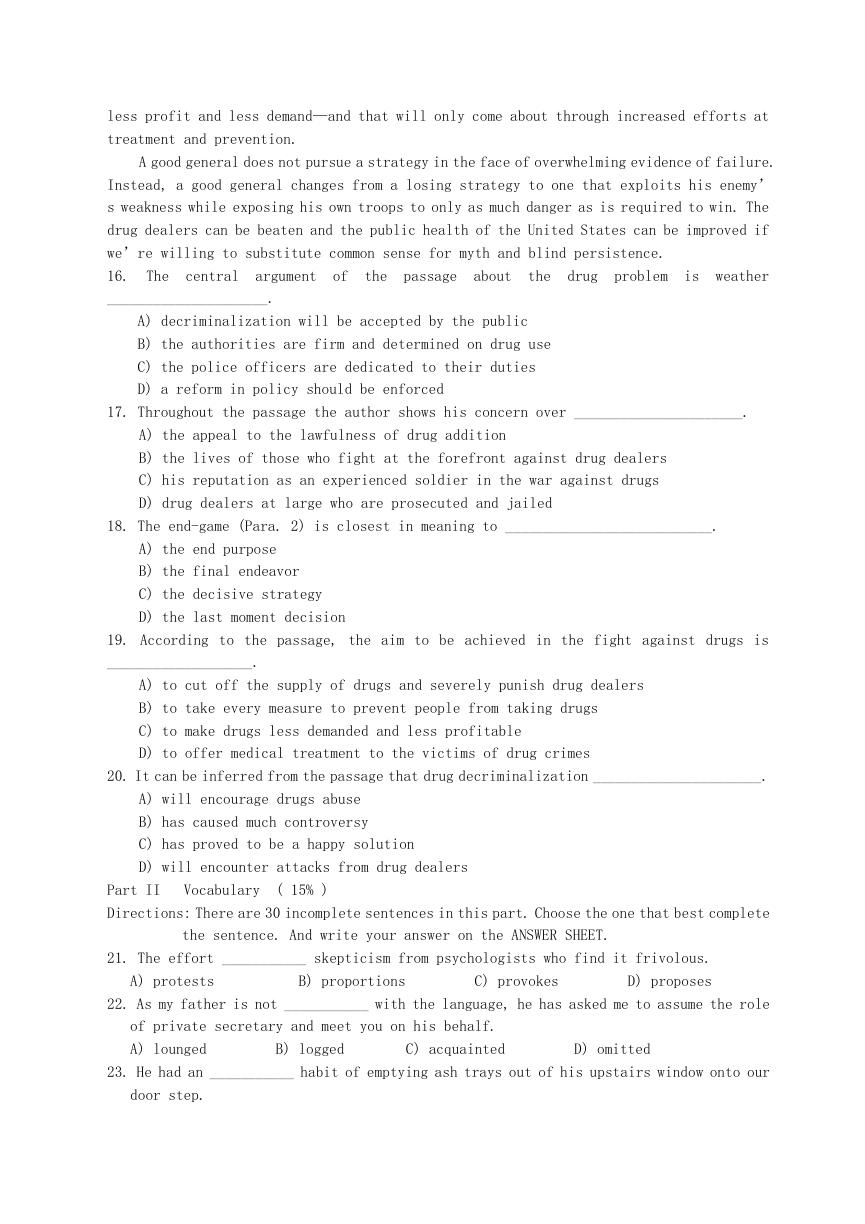
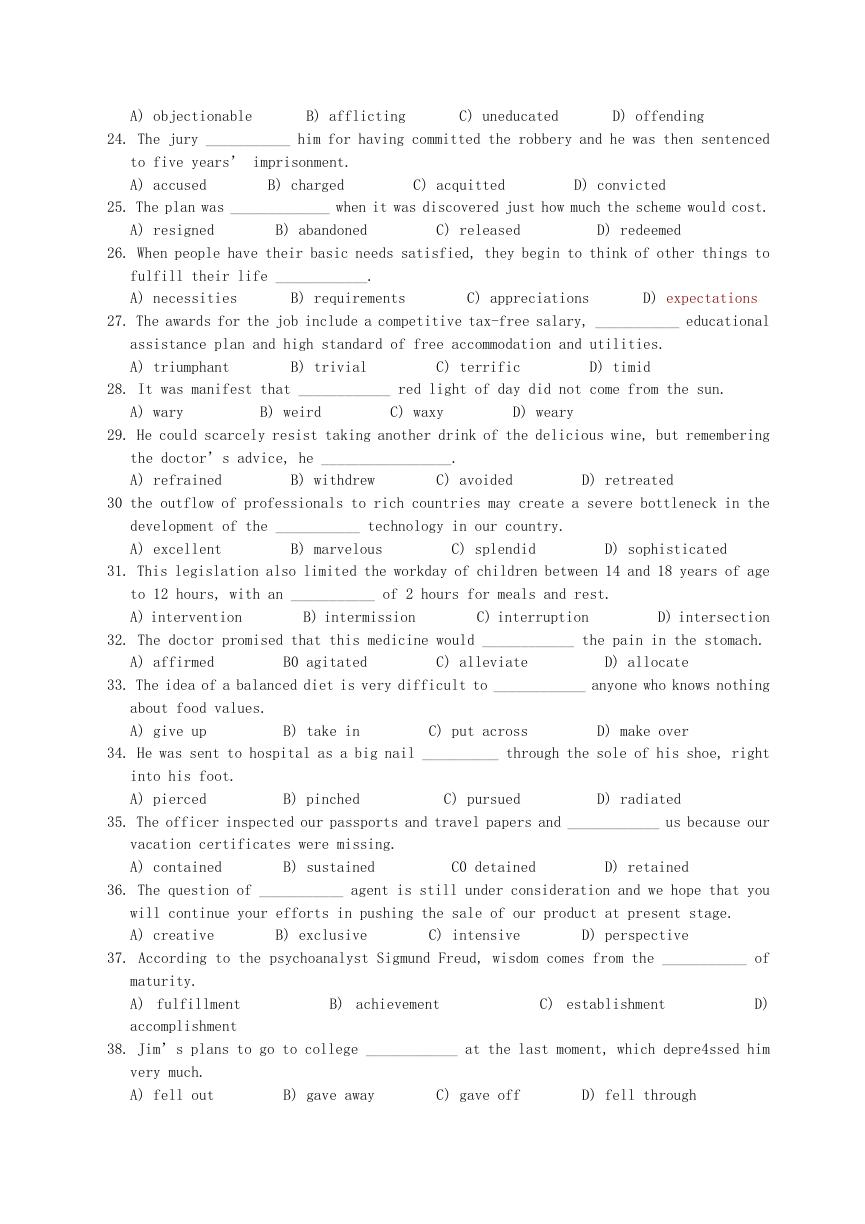








 2023年江西萍乡中考道德与法治真题及答案.doc
2023年江西萍乡中考道德与法治真题及答案.doc 2012年重庆南川中考生物真题及答案.doc
2012年重庆南川中考生物真题及答案.doc 2013年江西师范大学地理学综合及文艺理论基础考研真题.doc
2013年江西师范大学地理学综合及文艺理论基础考研真题.doc 2020年四川甘孜小升初语文真题及答案I卷.doc
2020年四川甘孜小升初语文真题及答案I卷.doc 2020年注册岩土工程师专业基础考试真题及答案.doc
2020年注册岩土工程师专业基础考试真题及答案.doc 2023-2024学年福建省厦门市九年级上学期数学月考试题及答案.doc
2023-2024学年福建省厦门市九年级上学期数学月考试题及答案.doc 2021-2022学年辽宁省沈阳市大东区九年级上学期语文期末试题及答案.doc
2021-2022学年辽宁省沈阳市大东区九年级上学期语文期末试题及答案.doc 2022-2023学年北京东城区初三第一学期物理期末试卷及答案.doc
2022-2023学年北京东城区初三第一学期物理期末试卷及答案.doc 2018上半年江西教师资格初中地理学科知识与教学能力真题及答案.doc
2018上半年江西教师资格初中地理学科知识与教学能力真题及答案.doc 2012年河北国家公务员申论考试真题及答案-省级.doc
2012年河北国家公务员申论考试真题及答案-省级.doc 2020-2021学年江苏省扬州市江都区邵樊片九年级上学期数学第一次质量检测试题及答案.doc
2020-2021学年江苏省扬州市江都区邵樊片九年级上学期数学第一次质量检测试题及答案.doc 2022下半年黑龙江教师资格证中学综合素质真题及答案.doc
2022下半年黑龙江教师资格证中学综合素质真题及答案.doc